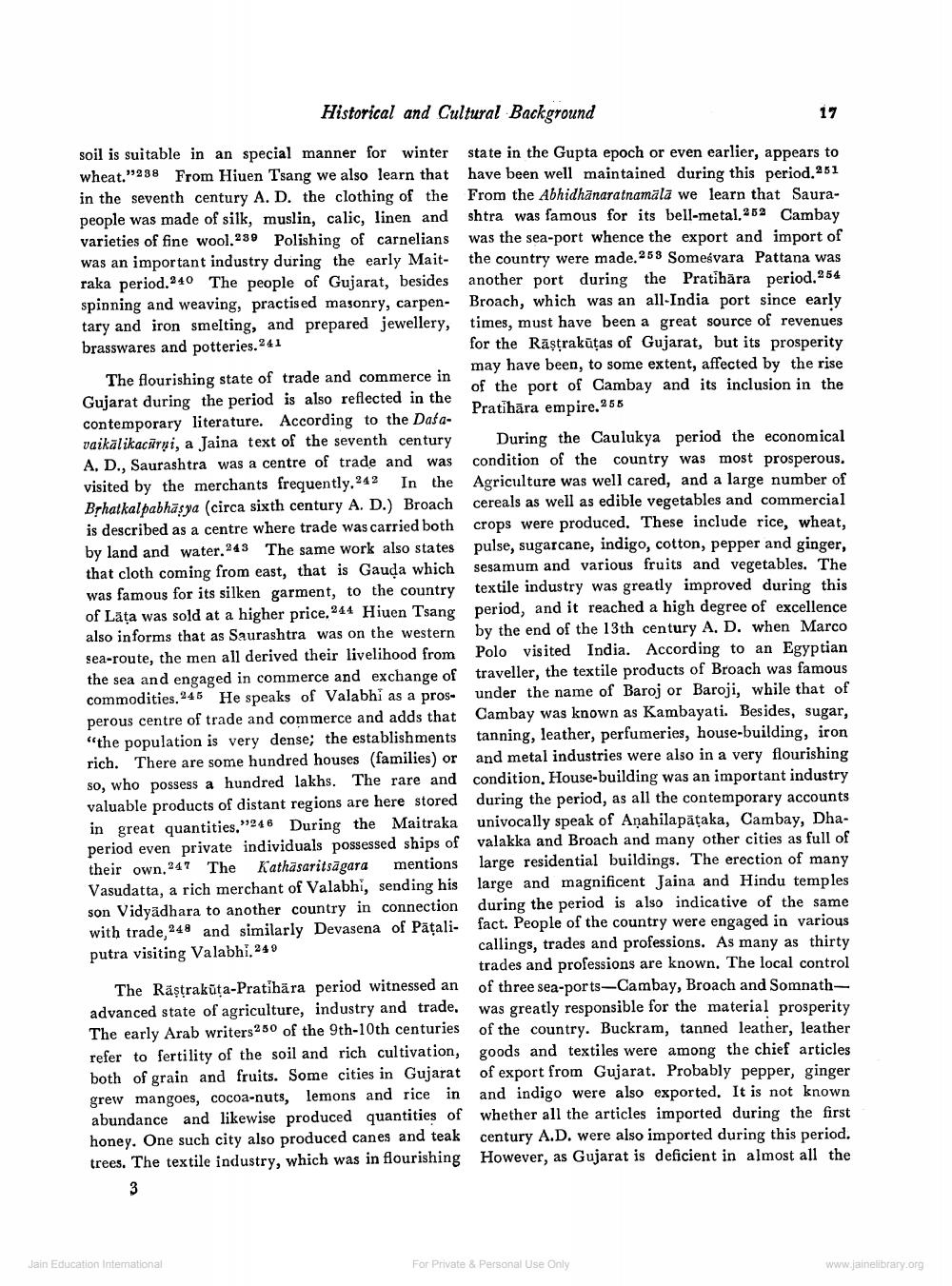________________
Historical and Cultural Background
17
soil is suitable in an special manner for winter state in the Gupta epoch or even earlier, appears to wheat."238 From Hiuen Tsang we also learn that have been well maintained during this period. 251 in the seventh century A. D. the clothing of the From the Abhidhanaratnamala we learn that Saurapeople was made of silk, muslin, calic, linen and shtra was famous for its bell-metal.252 Cambay varieties of fine wool.230 Polishing of carnelians was the sea-port whence the export and import of was an important industry during the early Mait- the country were made.258 Somesvara Pattana was raka period.240 The people of Gujarat, besides another port during the Pratihära period. 254 spinning and weaving, practised masonry, carpen- Broach, which was an all-India port since early tary and iron smelting, and prepared jewellery, times, must have been a great source of revenues brasswares and potteries.241
for the Răstrakütas of Gujarat, but its prosperity
may have been, to some extent, affected by the rise The flourishing state of trade and commerce in
of the port of Cambay and its inclusion in the Gujarat during the period is also reflected in the
Pratihāra empire.256 contemporary literature. According to the Dasavaikälikacírni, a Jaina text of the seventh century During the Caulukya period the economical A, D., Saurashtra was a centre of trade and was condition of the country was most prosperous. visited by the merchants frequently.242 In the Agriculture was well cared, and a large number of Bphatkalpabhāsya (circa sixth century A. D.) Broach cereals as well as edible vegetables and commercial is described as a centre where trade was carried both crops were produced. These include rice, wheat, by land and water.243 The same work also states pulse, sugarcane, indigo, cotton, pepper and ginger, that cloth coming from east, that is Gauda which sesamum and various fruits and vegetables. The was famous for its silken garment, to the country textile industry was greatly improved during this of Läța was sold at a higher price,244 Hiuen Tsang period, and it reached a high degree of excellence also informs that as Saurashtra was on the western by the end of the 13th century A, D, when Marco sea-route, the men all derived their livelihood from Polo visited India. According to an Egyptian the sea and engaged in commerce and exchange of traveller, the textile products of Broach was famous commodities.245 He speaks of Valabhi as a pros- under the name of Baroj or Baroji, while that of perous centre of trade and commerce and adds that Cambay was known as Kambayati. Besides, sugar, "the population is very dense; the establishments tanning, leather, perfumeries, house-building, iron rich. There are some hundred houses (families) or and metal industries were also in a very flourishing So, who possess a hundred lakhs. The rare and condition. House-building was an important industry valuable products of distant regions are here stored during the period, as all the contemporary accounts in great quantities."246 During the Maitraka univocally speak of Anahilapātaka, Cambay, Dhaperiod even private individuals possessed ships of valakka and Broach and many other cities as full of their own. 247 The Kathāsaritsägara mentions large residential buildings. The erection of many Vasudatta, a rich merchant of Valabhi, sending his large and magnificent Jaina and Hindu temples son Vidyādhara to another country in connection during the period is also indicative of the same with trade, 248 and similarly Devasena of Patali- fact. People of the country were engaged in various putra visiting Valabhi,249
callings, trades and professions. As many as thirty
trades and professions are known. The local control The Räştrakūta-Pratihära period witnessed an of three sea-ports-Cambay, Broach and Somnathadvanced state of agriculture, industry and trade. was greatly responsible for the material prosperity The early Arab writers 250 of the 9th-10th centuries of the country. Buckram, tanned leather, leather refer to fertility of the soil and rich cultivation, goods and textiles were among the chief articles both of grain and fruits. Some cities in Gujarat of export from Gujarat. Probably pepper, ginger grew mangoes, cocoa-nuts, lemons and rice in and indigo were also exported. It is not known abundance and likewise produced quantities of whether all the articles imported during the first honey. One such city also produced canes and teak century A.D. were also imported during this period. trees. The textile industry, which was in flourishing However, as Gujarat is deficient in almost all the
Jain Education International
For Private & Personal Use Only
www.jainelibrary.org




